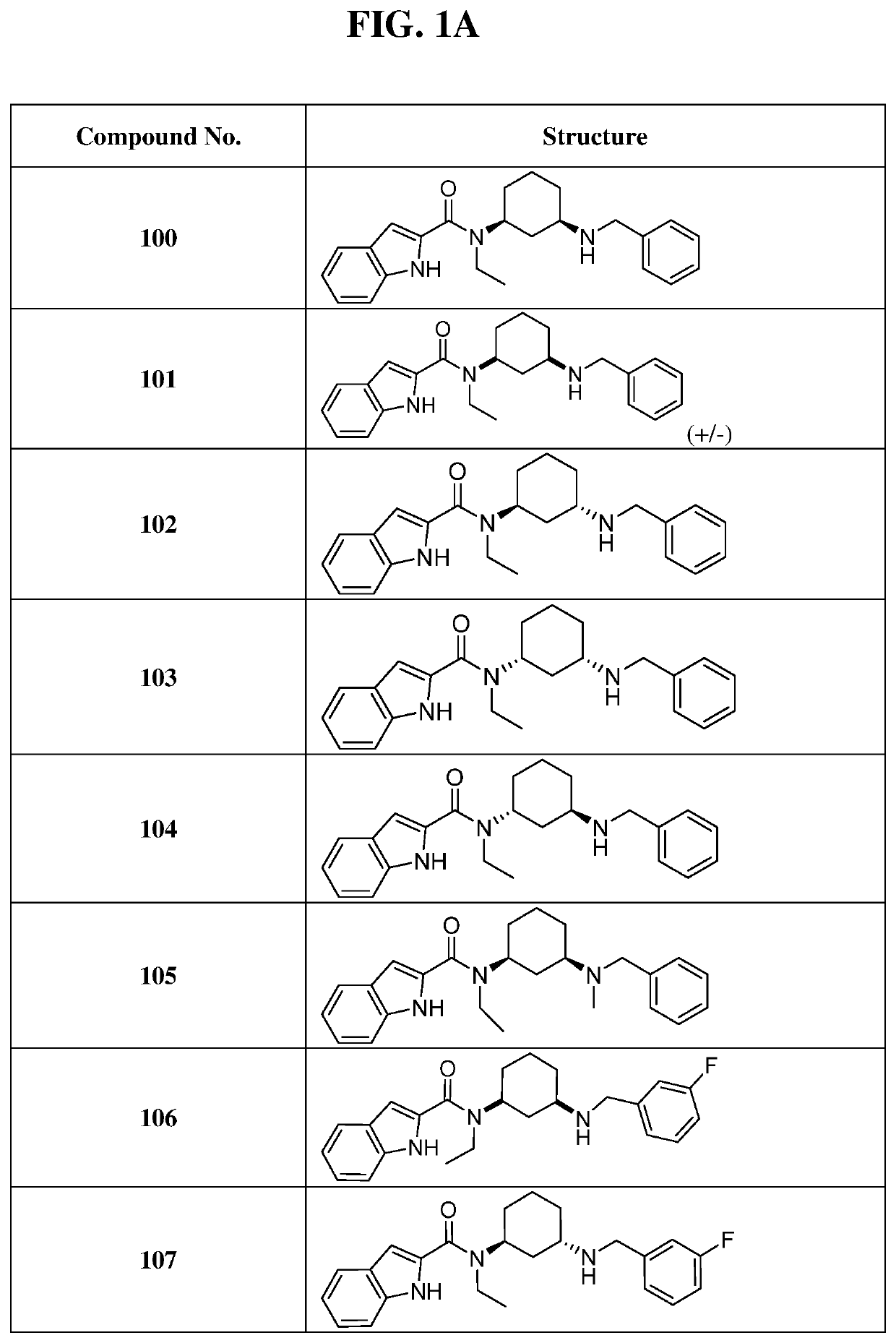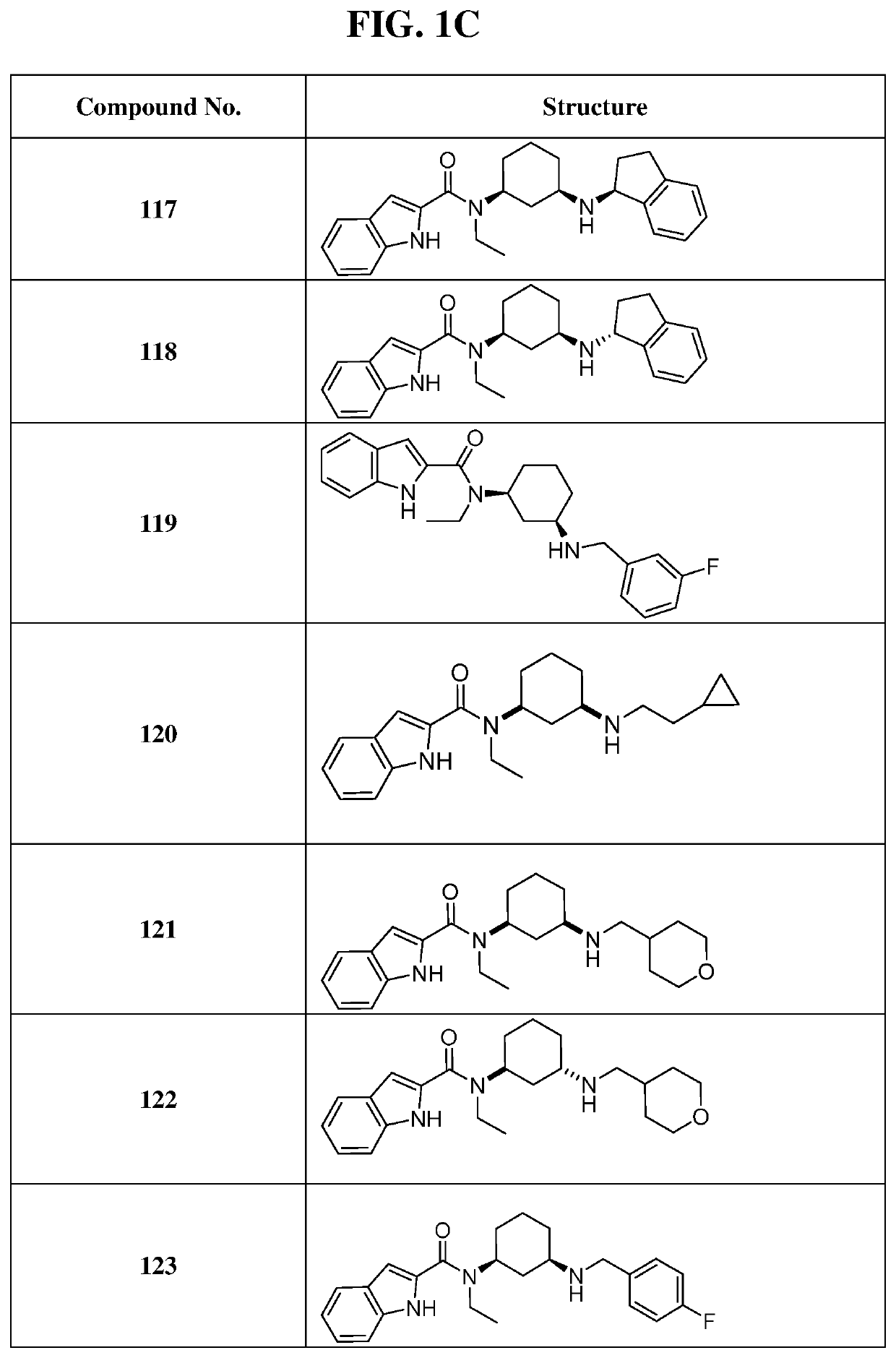Compounds, compositions and methods of use
a technology of compositions and compounds, applied in the field of compound compositions and methods of use, can solve problems such as difficulty in disaggregating, impaired function, and perhaps inability to be disaggregated
- Summary
- Abstract
- Description
- Claims
- Application Information
AI Technical Summary
Benefits of technology
Problems solved by technology
Method used
Image
Examples
example 1
of N-((1S,3R)-3-(benzylamino)cyclohexyl)-N-ethyl-1H-indole-2-carboxamide (Compound 100)
[0289]
[0290]General procedure for preparation of compound 2: To a mixture of tert-butyl ((1R,3S)-3-aminocyclohexyl)carbamate 1 (300 mg, 1.4 μmol, 1.0 eq), acetaldehyde (154 mg, 1.40 μmol, 1.00 eq) in 5 mL of CHCl3 was added acetic acid (25. mg, 420 μmol, 0.30 equivalents) under N2. The mixture was stirred for 0.5 hour at 25° C., then NaBH4 (53 mg, 1.4 μmol, 1.0 eq) was added, then stirred at 25° C. for another 11.5 hours under N2 atmosphere. The reaction was monitored by LCMS and allowed to run until complete. The reaction mixture was quenched with 5 ml of water and extracted with three 5 ml portions of dichloromethane. The combined organic layers were washed twice with 5 ml of brine, dried over Na2SO4, filtered and concentrated under reduced pressure to give a residue. The residue was purified by TLC (ethyl acetate:methanol=5 / 1) to afford 110 mg of ethyl amine 2 as a light yellow gum.
[0291]Genera...
example 2
of N-((1S,3R)-3-(benzyl(methyl)amino)cyclohexyl)-N-ethyl-1H-indole-2-carboxamide (Compound 105)
[0312]
[0313]General procedure for preparation of compound 105: To a mixture of compound 101 (80 mg, 213 μmol, 1.0 eq) and paraformaldehyde (19 mg, 213 μmol, 1.0 eq) in 1 mL of methanol was added acetic acid (1.3 mg, 21.3 μmol, 0.1 eq), NaBH3CN (14 mg, 213 μmol, 1.0 eq) in one portion at 25° C. under N2. The mixture was stirred at 25° C. for 24 hrs. The reaction was monitored by LCMS and allowed to run until complete. The reaction mixture was filtered and mother liquor was concentrated under reduced pressure to give a residue. The residue was purified by prep-HPLC (TFA condition) to afford 14.8 mg of compound 105 (13.6% yield, TFA salt) as colorless oil.
[0314]1H NMR (400 MHz, METHANOL-d4) δ ppm 7.60 (br s, 1H) 7.38-7.51 (m, 6H) 7.21 (br s, 1H) 7.06 (br s, 1H) 6.79 (br s, 1H) 4.52 (br d, J=13.45 Hz, 1H) 4.37 (br s, 1H) 4.20 (br d, J=13.01 Hz, 1H) 3.72 (br s, 2H) 3.46 (br s, 1H) 2.75 (br d, J...
example 3
of N-ethyl-N-((1S,3R)-3-((3-fluorobenzyl)amino)cyclohexyl)-1H-indole-2-carboxamide (Compound 106) and N-ethyl-N-((1S,3S)-3-((3-fluorobenzyl)amino)cyclohexyl)-1H-indole-2-carboxamide (Compound 107)
[0316]
[0317]General procedure for preparation of compound 6: A mixture of compound 5 (3.0 g, 14.0 mmol, 1.0 eq), ethanamine (951 mg, 21 mmol, 1.5 eq), acetic acid (84.5 mg, 1.4 mmol, 81 μL, 0.1 eq) in 30 mL of methanol was stirred at 25° C. for 0.5 h. To the mix was added NaBH3CN (1.8 g, 28 mmol, 2.0 eq) and then the mixture was stirred at 25° C. for 11 hours. The reaction was monitored by TLC and allowed to run until complete. The reaction mixture was quenched by adding 10 mL of water, then concentrated under reduced pressure to remove methanol. It was extracted with three 20 mL portions of ethyl acetate. The combined organic layers were washed with 20 mL of brine, dried over Na2SO4, filtered and concentrated under reduced pressure to give 3.8 g of the desired compound 6 as acrude yellow o...
PUM
| Property | Measurement | Unit |
|---|---|---|
| Mass | aaaaa | aaaaa |
| Force | aaaaa | aaaaa |
| Force | aaaaa | aaaaa |
Abstract
Description
Claims
Application Information
 Login to View More
Login to View More - R&D
- Intellectual Property
- Life Sciences
- Materials
- Tech Scout
- Unparalleled Data Quality
- Higher Quality Content
- 60% Fewer Hallucinations
Browse by: Latest US Patents, China's latest patents, Technical Efficacy Thesaurus, Application Domain, Technology Topic, Popular Technical Reports.
© 2025 PatSnap. All rights reserved.Legal|Privacy policy|Modern Slavery Act Transparency Statement|Sitemap|About US| Contact US: help@patsnap.com



